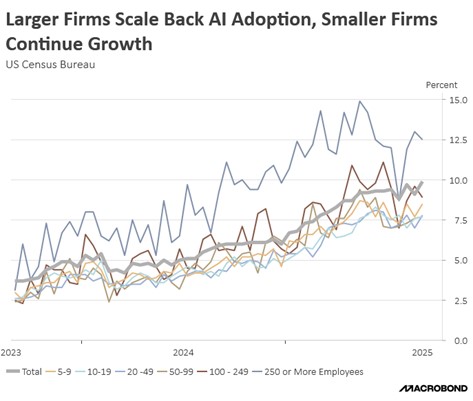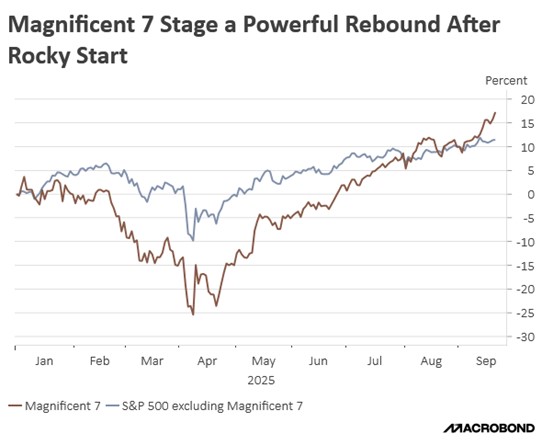by Patrick Fearon-Hernandez, CFA | PDF
Now that the federal government’s record-breaking shutdown over budget issues has ended, agencies have been releasing batches of delayed economic reports. In some cases, officials have warned the reports may never be released, given that statisticians can’t go back in time and collect certain data. The prime examples of that are the consumer price index and the monthly unemployment rate, which is based on a nearly real-time survey of households. Nevertheless, other reports are coming out now, and even though we have written up some of them with a quick, concise analysis in our Daily Comment, we think it would be useful to provide a more in-depth analysis of some of these catch-up reports, along with their implications for investors. We will focus on the recently released data for August construction spending and September durable goods orders, which together show a nuanced impact from today’s big boom in artificial intelligence (AI) investment.
August construction spending rose modestly by a seasonally adjusted 0.2%, following a similar gain of 0.2% in July and a 0.5% rise in June. Private residential construction spending jumped 0.8%, accelerating from its July gain of 0.7% and marking its third straight monthly increase. In contrast, August public works spending was flat. Even more interesting, August spending on private nonresidential construction fell 0.3%, after a decline of 0.5% in July. In fact, this proxy for commercial construction has only posted two monthly gains (of 0.1% each) over the last year. Total construction spending in August was down 1.6% from the same month one year earlier, with public works spending up 1.8% but private residential outlays down 1.5% and private nonresidential outlays down a whopping 4.3% (see chart on next page).
Given all the news stories about artificial intelligence firms spending massively on data centers, cooling equipment, and other AI infrastructure, some investors might be surprised at the recent relative weakness in commercial construction outlays. What explains this weakness? In large part, the problem appears to be that the big AI boom hasn’t been enough to offset this year’s anemic corporate investment outside the AI sector. One reason for that has probably been the uncertainty over US trade policy this year, which has discouraged some new investment despite the lucrative tax incentives in this year’s “Big, Beautiful” tax and spending bill. We think that another likely reason has probably been the weak consumer spending by lower-income households.
Separately, September durable goods orders rose by a seasonally adjusted 0.5%, marking their second straight monthly gain but slowing from their increase of 3.0% in August. Of course, durable goods orders are often driven by transportation equipment, where just a few airliner orders can have a big impact. September durable goods orders excluding transportation rose 0.6%, marking their fifth straight monthly increase and accelerating from their rise of 0.5% in the previous month. Finally, the durable goods report also includes a proxy for corporate capital investment. In September, non-defense capital goods orders ex-aircraft rose by 0.9%, after similar gains of 0.9% in August and 0.7% in July. Overall durable goods orders in September were up 9.6% year-over-year, while durable orders ex-transport were up a more modest 4.6% and non-defense capital goods orders ex-aircraft were up 5.3%.
The chart below shows the year-over-year change in non-defense capital goods orders ex-aircraft since just before the Great Financial Crisis (GFC). The chart does show how this proxy for corporate capital investment has strengthened over the last couple of years. All the same, the annual growth in this spending is decidedly modest compared with the booms that occurred after the coronavirus pandemic, in the late 2010s, and in the years right after the GFC. Coupled with the relative weakness in commercial building discussed above, this data points to overall weakness in commercial equipment spending and is further evidence that most firms have become quite cautious about new investment, at least for the moment. Headwinds from policy uncertainty and weakness in some consumer sectors have weighed not only on building activity but also on equipment investment.
What does all this imply for investors looking forward to 2026? In our view, this year’s policy uncertainty is likely to dissipate in 2026 as the US strikes more trade deals and key court decisions are reached. Moreover, the Federal Reserve looks set to keep cutting interest rates. If these developments encourage a catch-up in corporate investment spending beyond the AI sector, it should support some re-acceleration in economic growth. Of course, lower-income households are still likely to be husbanding their resources, and that could limit overall growth in 2026. All the same, we see reason for optimism regarding overall economic growth, which could support US stock prices.






